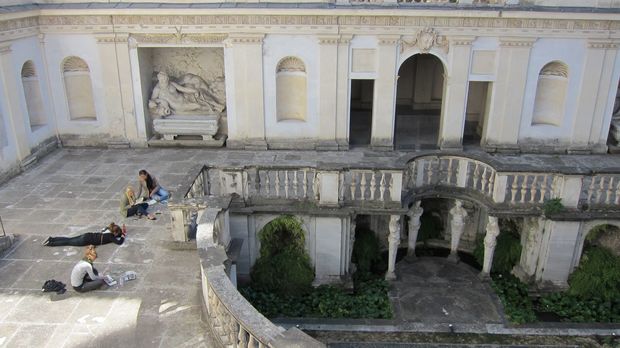Tyler in Rome and the Interconnectedness of Art, Architecture, and Culture

In 1966, Temple University’s Rome Program opened its doors in the historic Villa Caproni, a classic multi-story Roman palazzo turned full-support academic center seated just off the east bank of the River Tiber. For more than 50 years, Tyler students have been encouraged to spend a summer, a semester, or a full year in Italy in order to fulfill a variety of graduate and undergraduate requirements in both the fine arts and built disciplines. Hailed as a cultural, social, and historical hub, Rome offers a view of the ancient and modern worlds coexisting with a vibrancy found little elsewhere.
Mark Shetabi, Associate Professor of Painting at Tyler and Director of Tyler at Temple Rome, uses his leadership position to foster creativity, oversee program-wide curriculum, and ensure an alignment between Tyler’s main campus and Rome.
Attendance involves a mandatory course in Italian, and Shetabi notes that many Tyler students generally enroll in art history, studio courses and other programs such as political science, anthropology, sociology, water studies, sports medicine, and business are available, among several others. Shetabi speaks to the benefit of studying a fine arts track in a city like Rome, citing “the chance to interact directly with the primary works — Rome is thought of as a center and destination for art. There’s a huge stratum of history here. Etruscan, Roman, Medieval, Renaissance, Baroque, Mussolini, modern day.” Offering unparalleled engagement with the archaic and the contemporary through the building of restaurants, museums, shops, and residences around the existing ruins, Rome is a city that is in constant conversation with itself. “In America,” Shetabi says, “we’re not always as sentimental about our past except in a few designated areas like Philadelphia’s Independence Hall. In Rome, it’s all right there. Near the Colosseum, there’s this dig where the gladiators trained, and then right next to it is a bar, and then a café. The breadth of interconnectedness is so interesting and constantly changing.”
For Tyler students who do choose to pursue any of the available art programs, there’s something invaluable about being able to interact with foundational works in real life. Shetabi says, “If you Google a painting by Caravaggio, or see it in many Art History textbooks, the work is nearly always shown as a rectangle. But when you’re walking into the churches here and you’re looking at the paintings, you realize that they’re often meant to be viewed from the side and appear as trapezoid shapes. The phenomenology of the body and the viewing position is a fundamental thing that you can’t grasp fully from an image on a screen.”
In an effort to support the kinetic overlap of the design and built environments as they’re encouraged on Tyler’s main campus, Shetabi suggests taking a course called Rome Sketchbook, which focuses on walking through the city, observing, and drawing. Roman architecture as it exists in its most primitive state informs lots of modern building design, and this freedom to explore allows for students to view the city as their classroom outside of Villa Caproni. “We have these amazing museums in America — The Met, MoMA, but you have to pay to get in and it’s a sort of separate experience from the cities they're a part of. In Rome, you’ll walk down the street and then suddenly there’s a fountain by Bernini. The city is so fundamental to the classes, and the trips both within and beyond Rome offer such a rich experience.”
Shetabi says students leave their time in Rome with a new appreciation for “seeing things in the real.” He also notes the lasting impact that study abroad has on people of all ages. “Many of Tyler’s most illustrious alumni studied in Rome. I recently did some research into some of these alumni, who have shown work in some of the best galleries and museums in the world, and many mention their time studying in Rome as being particularly meaningful.”
Every year, Tyler at Temple Rome hosts Festa di Roma on Tyler’s main campus. This February 6-18, students will be showcasing artwork from their time abroad in the Stella Elkins Tyler Gallery, academic advisors will host info sessions about study abroad, and Shetabi and other faculty in Rome will host virtual panels about life and work in Italy. “Rome is one of the really special things about being a student at Tyler,” Shetabi says. “There are lots of schools that might have more resources than Tyler that don’t have a program like this. It’s been amazing that we’ve been able to maintain a presence like this in Rome. My wish is that any student can come here if they want to."
